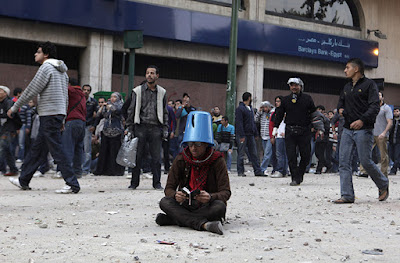Many people have told me about this rap by Shadia Mansour, and the video, plus the more
amateur ones that came out before this one. Thanks to all of you.
A new version of the vid came out in summer 2011, and here it is:
It's a powerful rap, a very well-made vid, and Shadia's delivery and her rhymes are compelling. The theme is: "they" are trying to take the kufiya, to make it into "fashion," in many colors, just like they have tried to steal our culture and our land and our dignity. But the kufiya remains Arab, and we hold on to it tenaciously. Please go
here for the full lyrics, in Arabic and in English translation, courtesy, Revolutionary Arab Rap.
I am in general sympathy and solidarity with the message. But if you have been following this blog, you might guess that I have a somewhat different take on the international uses of the kufiya than Shadia.
First, the song and video to some degree undercut the message that the kufiya is Arab in some kind of essential way. Shadia raps,
هيك لبسنا الكوفية هويتنا الأساسية الكوفية كوفية عربية
This is how we wore the kufiya (our fundamental identity), the kufiya, the Arab kufiya.
But doesn't the fact that one is rapping, i.e., using a global cultural form, to express the notion of a fundamental or essential identity, problematize the notion of an essential Arab cultural identity? And what about the fact that M-1 of the progressive US rap group Ded Prez is shown at Shadia's side throughout much of the vid, wearing a kufiya? Does his presence support the claim that the kufiya is simply "Arab"? Or does it suggest that wearing the kufiya is a sign of solidarity with the Palestinian struggle, something that anyone, and not just Arabs, can wear to make such a statement?
Second, there is the problem of the "they" who have made the kufiya into "fashion" and who have "changed" its colors from red-and-white and black-and-white. As readers of this blog will know, I've looked at this issue quite carefully, and I have found no evidence to show that Israelis or Zionists are responsible for the fashionization and multi-colorization of the kufiya. I believe it is fair to criticize the turning of the kufiya into fashion (although I think the issue is not black or white), but it is not a Zionist plot. Yes, there were a couple cases where Israeli designers tried to
take advantage of the fashion trend, but this is a very minor part of the story. There are many more instances of Zionists making a fuss about the proliferation of kufiyas via the world of fashion (for example, the
flap over the Urban Outfitters kufiya and the
kerfuffle over Rachel Ray) than of Zionists successfully turning the kufiya into "their" national dress.
My position is: once Palestinians encouraged non-Palestinians to wear the kufiya in solidarity (which people started doing as early as 1970 or 1971), the kufiya ceased simply to be "Arab" or "Palestinian."
Moreover, many people wear kufiyas of all sorts of colors to express their solidarity with Palestinians.
And Syrian businessmen have been producing kufiyas, in many colors, and quite beautiful ones, for some time. You can even purchase them at the
Arab-American National Museum in Dearborn, Michigan.
Moreover, the kufiya has been embraced by many as a kind of global symbol of resistance, at Tahrir, in Libya, in the occupy movement, and so on. I've documented this extensively.
Finally, to call the kufiya "Arab" is somewhat chauvinist with regards to the Kurds, who have used it for decades as a symbol of identity and resistance. They call it the puşis.
Here's one example. I've not done much on the Kurdish uses, but hope to in future.
I'm not sure what sort of song you would do to get at the issues I raise (but hey, I'm just a blogger, not a songwriter), but I do think that Shadia falls a bit short in terms of articulating the complexities of the kufiya's uses, and I believe she falls back on nationalist rhetoric in a somewhat unreflective way. But I still like the song.
And I like the way she refashions that celebrated line from Mahmoud Darwish's poem, "Identity Card": "Record! I'm an Arab," and how she claims that the kufiya is her "identity card" (hawiya).
سجّل انا شادية منصور والحطة هويتي
Record it! I am Shadia Mansour and the kufiya is my identity.
Problem is, lots of us own those identity cards, and we wear them proudly.





















